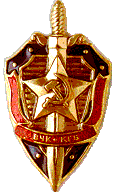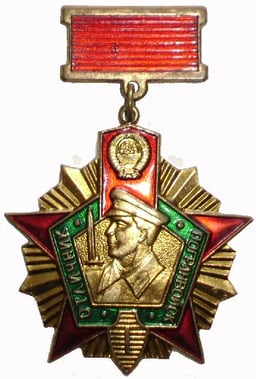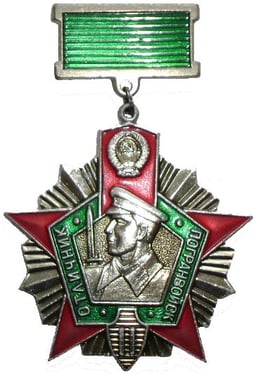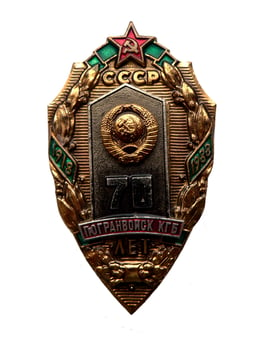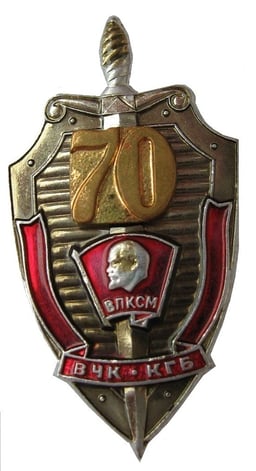KGB
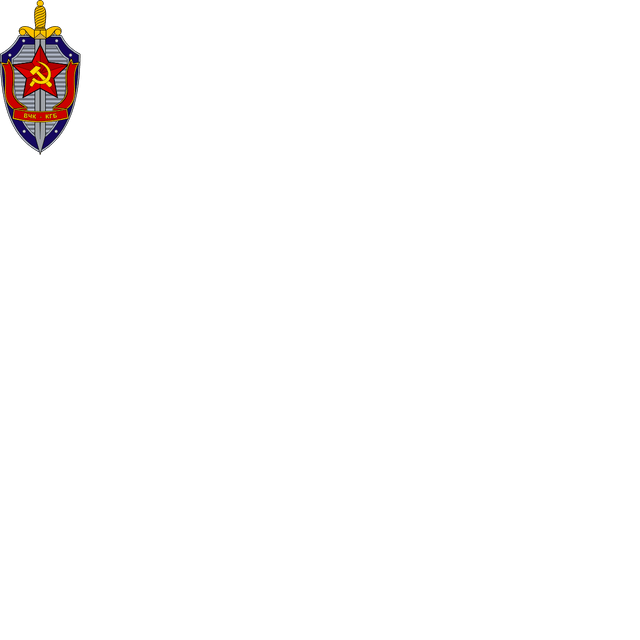
KGB

| **Комитет государственной безопасности** **КГБ СССР** Komitet gosudarstvennoy bezopasnosti KGB SSSR | |
 Lubyanka Building in 1985 | |
| Agency overview | |
|---|---|
| Formed | 13 March 1954 (1954-03-13) |
| Preceding agencies |
|
| Superseding agency |
|
| Type | State committee of union-republican jurisdiction |
| Jurisdiction | Central Committee & Sovnarkom (1954–90) Supreme Council & President (1990–91) |
| Headquarters | Lubyanka Square, 2 Moscow, Russian SFSR |
| Motto | Loyalty to the party – Loyalty to motherland Верность партии — Верность Родине |
| Agency executives |
|
| Child agencies |
|
The KGB (Russian: Комите́т Госуда́рственной Безопа́сности (КГБ), tr. Komitet Gosudarstvennoy Bezopasnosti, IPA: [kəmʲɪˈtʲet ɡəsʊˈdarstvʲɪnːəj bʲɪzɐˈpasnəsʲtʲɪ] (listen)), translated in English as Committee for State Security, was the main security agency for the Soviet Union from 1954 until its break-up in 1991. As a direct successor of preceding agencies such as the Cheka, NKGB, NKVD and MGB, the committee was attached to the Council of Ministers. It was the chief government agency of "union-republican jurisdiction", acting as internal security, intelligence and secret police. Similar agencies were constituted in each of the republics of the Soviet Union aside from Russian SFSR, and consisted of many ministries, state committees and state commissions.
The agency was a military service governed by army laws and regulations, in the same fashion as the Soviet Army or MVD Internal Troops. While most of the KGB archives remain classified, two online documentary sources are available.[1][2] Its main functions were foreign intelligence, counter-intelligence, operative-investigatory activities, guarding the State Border of the USSR, guarding the leadership of the Central Committee of the Communist Party and the Soviet Government, organization and ensuring of government communications as well as combating nationalism, dissent, and anti-Soviet activities.
In 1991, after the dissolution of the Soviet Union, the KGB was split into the Federal Security Service and the Foreign Intelligence Service of the Russian Federation.
After breaking away from Georgia in the early 1990s with Russian help, the self-proclaimed Republic of South Ossetia established its own KGB (keeping this unreformed name).[3] In addition, the Republic of Belarus has also established its own national security agency, the State Security Committee of the Republic of Belarus, the name and acronym of which is identical to the former Soviet KGB.
| **Комитет государственной безопасности** **КГБ СССР** Komitet gosudarstvennoy bezopasnosti KGB SSSR | |
 Lubyanka Building in 1985 | |
| Agency overview | |
|---|---|
| Formed | 13 March 1954 (1954-03-13) |
| Preceding agencies |
|
| Superseding agency |
|
| Type | State committee of union-republican jurisdiction |
| Jurisdiction | Central Committee & Sovnarkom (1954–90) Supreme Council & President (1990–91) |
| Headquarters | Lubyanka Square, 2 Moscow, Russian SFSR |
| Motto | Loyalty to the party – Loyalty to motherland Верность партии — Верность Родине |
| Agency executives |
|
| Child agencies |
|
Mode of operation
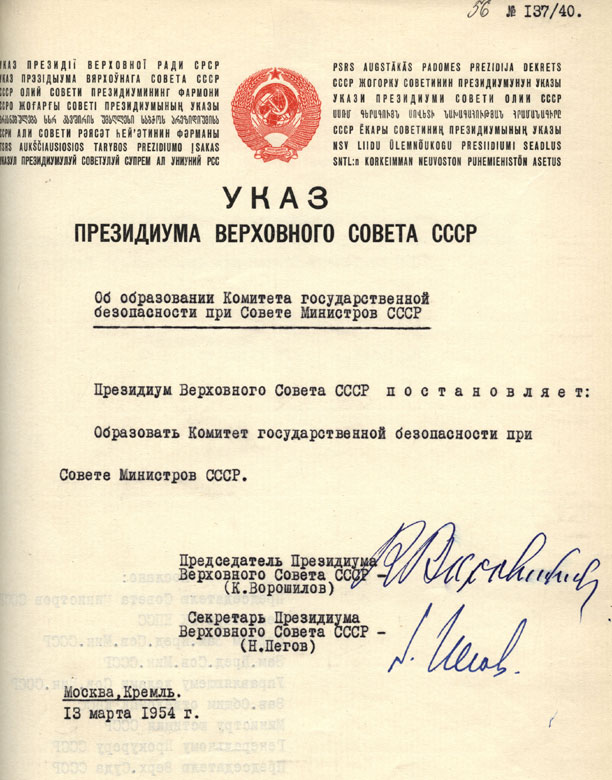
The ukase establishing the KGB
A Time magazine article in 1983 reported that the KGB was the world's most effective information-gathering organization.[4] It operated legal and illegal espionage residencies in target countries where a legal resident gathered intelligence while based at the Soviet embassy or consulate, and, if caught, was protected from prosecution by diplomatic immunity. At best, the compromised spy was either returned to the Soviet Union or was declared persona non grata and expelled by the government of the target country. The illegal resident spied, unprotected by diplomatic immunity, and worked independently of Soviet diplomatic and trade missions, (cf. the non-official cover CIA officer). In its early history, the KGB valued illegal spies more than legal spies, because illegal spies infiltrated their targets with greater ease. The KGB residency executed four types of espionage: (i) political, (ii) economic, (iii) military-strategic, and (iv) disinformation, effected with "active measures" (PR Line), counter-intelligence and security (KR Line), and scientific–technological intelligence (X Line); quotidian duties included SIGINT (RP Line) and illegal support (N Line).[5]
The KGB classified its spies as agents (intelligence providers) and controllers (intelligence relayers). The false-identity or legend assumed by a USSR-born illegal spy was elaborate, using the life of either a "live double" (participant to the fabrications) or a "dead double" (whose identity is tailored to the spy). The agent then substantiated his or her legend by living it in a foreign country, before emigrating to the target country, thus the sending of US-bound illegal residents via the Soviet embassy in Ottawa, Canada. Tradecraft included stealing and photographing documents, code-names, contacts, targets, and dead letter boxes, and working as a "friend of the cause" or as agents provocateurs, who would infiltrate the target group to sow dissension, influence policy, and arrange kidnappings and assassinations.[6]
History
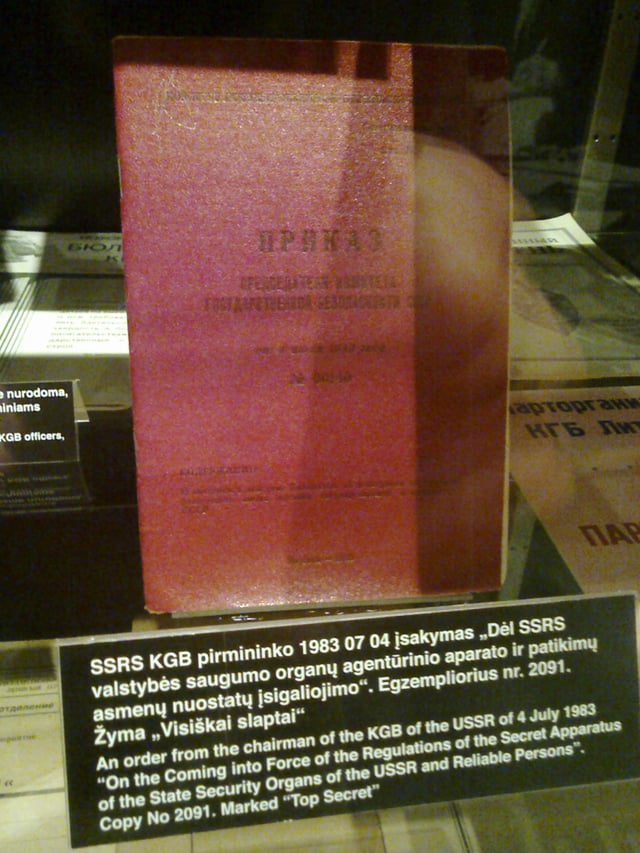
KGB Regulation seen in the Museum of Occupations and Freedom Fights in Vilnius
Mindful of ambitious spy chiefs—and after deposing Premier Nikita Khrushchev—Secretary Leonid Brezhnev and the CPSU knew to manage the next over-ambitious KGB Chairman, Aleksandr Shelepin (1958–61), who facilitated Brezhnev's palace coup d'état against Khrushchev in 1964 (despite Shelepin not then being in the KGB). With political reassignments, Shelepin protégé Vladimir Semichastny (1961–67) was sacked as KGB Chairman, and Shelepin himself was demoted from chairman of the Committee of Party and State Control to Trade Union Council chairman.
In the 1980s, the glasnost liberalisation of Soviet society provoked KGB Chairman Vladimir Kryuchkov (1988–91) to lead the August 1991 Soviet coup d'état attempt to depose President Mikhail Gorbachev. The thwarted coup d'état ended the KGB on 6 November 1991. The KGB's main successors are the FSB (Federal Security Service of the Russian Federation) and the SVR (Foreign Intelligence Service).
In the US
Between the World Wars
The GRU (military intelligence) recruited the ideological agent Julian Wadleigh, who became a State Department diplomat in 1936. The NKVD's first US operation was establishing the legal residency of Boris Bazarov and the illegal residency of Iskhak Akhmerov in 1934.[7] Throughout, the Communist Party USA (CPUSA) and its General Secretary Earl Browder, helped NKVD recruit Americans, working in government, business, and industry.
Other important, low-level and high-level ideological agents were the diplomats Laurence Duggan and Michael Whitney Straight in the State Department, the statistician Harry Dexter White in the Treasury Department, the economist Lauchlin Currie (an FDR advisor), and the "Silvermaster Group", headed by statistician Greg Silvermaster, in the Farm Security Administration and the Board of Economic Warfare.[8] Moreover, when Whittaker Chambers, formerly Alger Hiss's courier, approached the Roosevelt Government—to identify the Soviet spies Duggan, White, and others—he was ignored. Hence, during the Second World War (1939–45)—at the Tehran (1943), Yalta (1945), and Potsdam (1945) conferences—Big Three Ally Joseph Stalin of the USSR, was better informed about the war affairs of his US and UK allies than they were about his.[9]
| **Chronology of Soviet secret police agencies** | ||
| ||
| 1917–1922 | Cheka under SNK of the RSFSR (All-Russian Extraordinary Commission) | |
| 1922–1923 | GPU under NKVD of the RSFSR (State Political Directorate) | |
| 1923–1934 | OGPU under SNK of the USSR (Joint State Political Directorate) | |
| 1934–1941 | NKVD of the USSR (People's Commissariat for Internal Affairs) | |
| 1941 | MGB of the USSR (Ministry of State Security) | |
| 1941–1943 | GUGB of the NKVD of the USSR (Main Directorate of State Security of People's Commissariat for Internal Affairs) | |
| 1943–1946 | NKGB of the USSR (People's Commissariat for State Security) | |
| 1946–1953 | MGB of the USSR (Ministry of State Securtiy) | |
| 1953–1954 | MVD of the USSR (Ministry of Internal Affairs) | |
| 1954–1978 | KGB under SM of the USSR (Committee for State Security) | |
| 1978–1991 | KGB of the USSR (Committee for State Security) | |
| 1991 | MSB of the USSR (Interrepublican Security Service) | |
| 1991 | TsSB of the USSR (Central Intelligence Service) | |
| 1991 | Committee of protection of the USSR state border | |
Soviet espionage was at its most successful in collecting scientific and technological intelligence about advances in jet propulsion, radar and encryption, which impressed Moscow, but stealing atomic secrets was the capstone of NKVD espionage against Anglo–American science and technology. To wit, British Manhattan Project team physicist Klaus Fuchs (GRU 1941) was the main agent of the Rosenberg spy ring.[10] In 1944, the New York City residency infiltrated top secret Los Alamos National Laboratory in New Mexico by recruiting Theodore Hall, a 19-year-old Harvard physicist.[11][12]
During the Cold War
The KGB failed to rebuild most of its US illegal resident networks. The aftermath of the Second Red Scare (1947–57) and the crisis in the CPUSA hampered recruitment. The last major illegal resident, Rudolf Abel (Vilyam Genrikhovich Fisher/"Willie" Vilyam Fisher), was betrayed by his assistant, Reino Häyhänen, in 1957.[13]
Recruitment then emphasised mercenary agents, an approach especially successful in scientific and technical espionage, since private industry practised lax internal security, unlike the US Government. One notable KGB success occurred in 1967, with the walk-in recruitment of US Navy Chief Warrant Officer John Anthony Walker. Over eighteen years, Walker enabled Soviet Intelligence to decipher some one million US Navy messages, and track the US Navy.[14]
In the late Cold War, the KGB was successful with intelligence coups in the cases of the mercenary walk-in recruits FBI counterspy Robert Hanssen (1979–2001) and CIA Soviet Division officer Aldrich Ames (1985–1994).[15]
In the Soviet Bloc
It was Cold War policy for the KGB of the Soviet Union and the secret services of the satellite states to extensively monitor public and private opinion, internal subversion and possible revolutionary plots in the Soviet Bloc. In supporting those Communist governments, the KGB was instrumental in crushing the Hungarian Revolution of 1956, and the Prague Spring of "Socialism with a Human Face", in 1968 Czechoslovakia.
During the Hungarian revolt, KGB chairman Ivan Serov personally supervised the post-invasion "normalization" of the country. In consequence, KGB monitored the satellite state populations for occurrences of "harmful attitudes" and "hostile acts"; yet, stopping the Prague Spring, deposing a nationalist Communist government, was its greatest achievement.
The KGB prepared the Red Army's route by infiltrating to Czechoslovakia many illegal residents disguised as Western tourists. They were to gain the trust of and spy upon the most outspoken proponents of Alexander Dubček's new government. They were to plant subversive evidence, justifying the USSR's invasion, that right-wing groups—aided by Western intelligence agencies—were going to depose the Communist government of Czechoslovakia. Finally, the KGB prepared hardline, pro-USSR members of the Communist Party of Czechoslovakia (CPC), such as Alois Indra and Vasiľ Škultéty, to assume power after the Red Army's invasion.[16]
The KGB's Czech success in the 1960s was matched with the failed suppression of the Solidarity labour movement in 1980s Poland. The KGB had forecast political instability consequent to the election of Archbishop of Kraków Karol Wojtyla as the first Polish Pope, John Paul II, whom they had categorised as "subversive" because of his anti-Communist sermons against the one-party PUWP régime. Despite its accurate forecast of crisis, the Polish United Workers' Party (PUWP) hindered the KGB's destroying the nascent Solidarity-backed political movement, fearing explosive civil violence if they imposed the KGB-recommended martial law. Aided by their Polish counterpart, the Służba Bezpieczeństwa (SB), the KGB successfully infiltrated spies to Solidarity and the Catholic Church,[17] and in Operation X co-ordinated the declaration of martial law with Gen. Wojciech Jaruzelski and the Polish Communist Party;[18] however, the vacillating, conciliatory Polish approach blunted KGB effectiveness—and Solidarity then fatally weakened the Communist Polish government in 1989.
Suppressing internal dissent
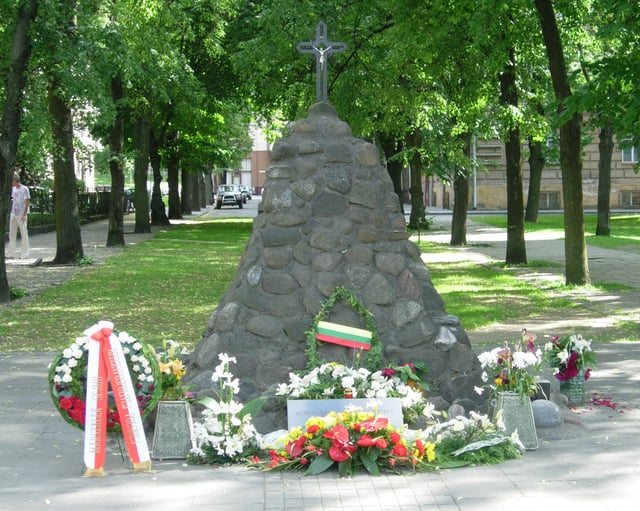
Monument to victims of KGB / NKVD operations in Vilnius, Lithuania
During the Cold War, the KGB actively sought to combat "ideological subversion" – anti-communist political and religious ideas and the dissidents who promoted them – which was generally dealt with as a matter of national security in discouraging influence of hostile foreign powers. After denouncing Stalinism in his secret speech On the Personality Cult and its Consequences in 1956, head of state Nikita Khrushchev lessened suppression of "ideological subversion". As a result, critical literature re-emerged, including the novel One Day in the Life of Ivan Denisovich (1962), by Aleksandr Solzhenitsyn, who was code-named PAUK ("spider") by the KGB. After Khrushchev's deposition in 1964, Leonid Brezhnev reverted the State and KGB to actively harsh suppression; house searches to seize documents and the continual monitoring of dissidents became routine again. To wit, in 1965, such a search-and-seizure operation yielded Solzhenitsyn manuscripts of "slanderous fabrications", and the subversion trial of the novelists Andrei Sinyavsky and Yuli Daniel; Sinyavsky (alias "Abram Tertz"), and Daniel (alias "Nikolai Arzhak"), were captured after a Moscow literary-world informant told KGB when to find them at home.[19]
In 1967, the campaign of this suppression increased under new KGB Chairman Yuri Andropov. After suppressing the Prague Spring, KGB Chairman Andropov established the Fifth Directorate to monitor dissension and eliminate dissenters. He was especially concerned with Aleksandr Solzhenitsyn and Andrei Sakharov, "Public Enemy Number One".[20] Andropov failed to expel Solzhenitsyn before 1974; but did internally exile Sakharov to Gorky in 1980. The KGB failed to prevent Sakharov's collecting his Nobel Peace Prize in 1975, but did prevent Yuri Orlov collecting his Nobel Prize in 1978; Chairman Andropov supervised both operations.
KGB dissident-group infiltration featured agents provocateurs pretending "sympathy to the cause", smear campaigns against prominent dissidents, and show trials; once imprisoned, the dissident endured KGB interrogators and sympathetic informant cell-mates. In the event, Mikhail Gorbachev's glasnost policies lessened persecution of dissidents; he was effecting some of the policy changes they had been demanding since the 1970s.[21]
Notable operations
With the Trust Operation (1921–1926), the OGPU successfully deceived some leaders of the right-wing, counter-revolutionary White Guards back to the USSR for execution.
NKVD infiltrated and destroyed Trotskyist groups; in 1940, the Spanish agent Ramón Mercader assassinated Leon Trotsky in Mexico City.
KGB favoured active measures (e.g. disinformation), in discrediting the USSR's enemies.
For war-time, KGB had ready sabotage operations arms caches in target countries.
In the 1960s, acting upon the information of KGB defector Anatoliy Golitsyn, the CIA counter-intelligence chief James Jesus Angleton believed KGB had moles in two key places—the counter-intelligence section of CIA and the FBI's counter-intelligence department—through whom they would know of, and control, US counter-espionage to protect the moles and hamper the detection and capture of other Communist spies. Moreover, KGB counter-intelligence vetted foreign intelligence sources, so that the moles might "officially" approve an anti-CIA double agent as trustworthy. In retrospect, the captures of the moles Aldrich Ames and Robert Hanssen proved that Angleton, though ignored as over-aggressive, was correct, despite the fact that it cost him his job at CIA, which he left in 1975.
In the mid-1970s, the KGB tried to secretly buy three banks in northern California to gain access to high-technology secrets. Their efforts were thwarted by the CIA. The banks were Peninsula National Bank in Burlingame, the First National Bank of Fresno, and the Tahoe National Bank in South Lake Tahoe. These banks had made numerous loans to advanced technology companies and had many of their officers and directors as clients. The KGB used the Moscow Narodny Bank Limited to finance the acquisition, and an intermediary, Singaporean businessman Amos Dawe, as the frontman.[23]
Bangladesh
On 2 February 1973, the Politburo, which was led by Yuri Andropov at the time, demanded that KGB members influence Bangladesh (which was then newly formed) where Sheikh Mujibur Rahman was scheduled to win parliamentary elections. During that time, the Soviet secret service tried very hard to ensure support for his party and his allies and even predicted an easy victory for him. In June 1975, Mujib formed a new party called BAKSAL and created a one-party state. Three years later, the KGB in that region increased from 90 to 200, and by 1979 printed more than 100 newspaper articles. In these articles, the KGB officials accused Ziaur Rahman, popularly known as "Zia", and his regime of having ties with the United States.[24]
In August 1979, the KGB accused some officers who were arrested in Dhaka in an overthrow attempt, and by October, Andropov approved the fabrication of a letter in which he stated that Muhammad Ghulam Tawab, an Air Vice-Marshal at the time, was the main plotter, which led the Bangladesh, Indian and Sri Lankan press to believe that he was an American spy. Under Andropov's command, Service A, a KGB division, falsified the information in a letter to Moudud Ahmed in which it said that he was supported by the American government and by 1981 even sent a letter accusing the Reagan administration of plotting to overthrow President Zia and his regime. The letter also mentioned that after Mujib was assassinated the United States contacted Khondaker Mostaq Ahmad to replace him as a short-term President. When the election happened in the end of 1979, the KGB made sure that the Bangladesh Nationalist Party would win. The party received 207 out of 300 seats, but the Zia regime did not last long, falling on 29 May 1981 when after numerous escapes, Zia was assassinated in Chittagong.[24]
Afghanistan

KGB special operative Igor Morozov sits on top of the BTR-60 armoured vehicle during his assignment to the Badakhshan province, c. 1982
The KGB started infiltrating Afghanistan as early as 27 April 1978. During that time, the Afghan Communist Party[25] was planning the overthrow of the imperially appointed Prime Minister Mohammed Daoud Khan. Under the leadership of Major General Sayed Mohammad Gulabzoy and Muhammad Rafi – code named Mammad and Niruz respectively – the Soviet secret service learned of the imminent uprising. Two days after the uprising, Nur Muhammad Taraki, leader of the People's Democratic Party of Afghanistan, issued a notice of concern to the Soviet ambassador Alexander Puzanov and the resident of Kabul-based KGB embassy Viliov Osadchy that they could have staged a coup three days earlier hence the warning. On that, both Puzanov and Osadchy dismissed Taraki's complaint and reported it to Moscow, which broke a 30-year contract with him soon after.[24][26]
The centre then realized that it was better for them to deal with a more competent agent, which at the time was Babrak Karmal, who later accused Nur Muhammad Taraki of taking bribes and even of having secretly contacted the United States embassy in Kabul. On that, the centre again refused to listen and instructed him to take a position in the Kabul residency by 1974. On 30 April 1978, Taraki, despite being cut off from any support, led the coup which later became known as Saur Revolution, and became the country's President, with Hafizullah Amin as Deputy-Prime Minister and Vice-President. On 5 December 1978, Taraki compared the April revolt to the Russian Revolution, which struck Vladimir Kryuchkov, the FCD chief of that time.[24][26]
On 27 March 1979, after losing the city of Herat, Amin became the next Prime Minister, and by 27 July became Minister of Defence as well. The centre though was concerned of his powers since the same month he issued them a complaint about lack of funds and demanded US$400,000,000. Furthermore, it was discovered that Amin had a master's degree from Columbia University, and that he preferred to communicate in English instead of Russian. Unfortunately for Moscow's intelligence services, Amin succeeded Taraki and by 16 September Radio Kabul announced that the PDPA received a fake request from Taraki concerning health issues among the party members. On that, the centre accused him of "terrorist" activities and expelled him from the Communist Party.[24][26]
The following day General Boris Ivanov, who was behind the mission in Kabul along with General Lev Gorelov and Deputy Defense Minister Ivan Pavlovsky, visited Amin to congratulate him on his election to power. On the same day the KGB decided to imprison Sayed Gulabzoy as well as Muhammad Watanjar and Asadullah Sarwari but while in captivity and under an investigation all three denied the allegation that the current Minister of Defence was an American secret agent. The denial of claims was passed on to Yuri Andropov and Leonid Brezhnev, who as the main chiefs of the KGB proposed operation Raduga to save the life of Gulabzoy and Watanjar and send them to Tashkent from Bagram airbase by giving them fake passports. With that and a sealed container in which an almost breathless Sarwari was laying, they came to Tashkent on 19 September.[24][26]
During the continued investigation in Tashkent, the three were put under surveillance in one of the rooms for as long as four weeks where they were investigated for the reliability of their claims by the KGB. Soon after, they were satisfied with the results and sent them to Bulgaria for a secret retreat. On 9 October, the Soviet secret service had a meeting in which Bogdanov, Gorelov, Pavlonsky and Puzanov were the main chiefs who were discussing what to do with Amin who was very harsh at the meeting. After the two-hour meeting they began to worry that Amin will establish an Islamic Republic in Afghanistan and decided to seek a way to put Karmal back in. They brought him and three other ministers secretly to Moscow during which time they discussed how to put him back in power. The decision was to fly him back to Bagram airbase by 13 December. Four days later, Amin's nephew, Asadullah, was taken to Moscow by the KGB for acute food poisoning treatment.[24][26]
On 19 November 1979, the KGB had a meeting on which they discussed Operation Cascade, which was launched earlier that year. The operation carried out bombings with the help of GRU and FCD.[26] On 27 December, the centre received news of the Darul Aman Palace, that KGB Special Forces Alpha and Zenith Group, supported by the 154th OSN GRU, also known as Muslim battalion and paratroopers from the 345th Guards Airborne Regiment stormed the Tajbeg Palace in Afghanistan and killed Afghan President Hafizullah Amin and his 100–150 personal guards.[27] His 11-year-old son died due to shrapnel wounds.[28] The Soviets installed Babrak Karmal as Amin's successor. Several other government buildings were seized during the operation, including the Ministry of Interior building, the Internal Security (KHAD) building, and the General Staff building (Darul Aman Palace). Out of the 54 KGB operators that assaulted the palace, 5 were killed in action, including Colonel Grigori Boyarinov, and 32 were wounded. Alpha Group veterans call this operation one of the most successful in the group's history. In June 1981, there were 370 members in the Afghan-controlled KGB intelligence service throughout the nation which were under the command of Ahmad Shah Paiya and had received all the training they need in the Soviet Union. By May 1982 the Ministry of Internal Affairs was set up in Afghanistan under the command of KHAD. In 1983 Boris Voskoboynikov became the next head of the KGB while Leonid Kostromin became his Deputy Minister.[26]
August 1991 coup
On 18 August 1991, Chairman of the KGB Vladimir Kryuchkov, along with seven other Soviet leaders, formed the State Committee on the State of Emergency and attempted to overthrow the government of the Soviet Union. The purpose of the attempted coup d'état was to preserve the integrity of the Soviet Union and the constitutional order. President Mikhail Gorbachev was arrested and ineffective attempts were made to seize power. Within two days, the attempted coup collapsed.[29]
The KGB was succeeded by the Federal Counterintelligence Service (FSK) of Russia, which was succeeded by the Federal Security Service of the Russian Federation (FSB).[30]
Organization
Republican affiliations
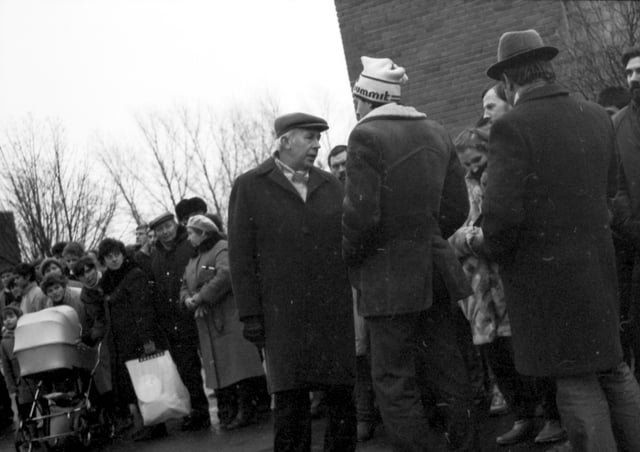
Head of KGB in Lithuania Eduardas Eismuntas, January 1990

Erkebek Abdulaev, author and former KGB lieutenant colonel in Kyrgyzstan.
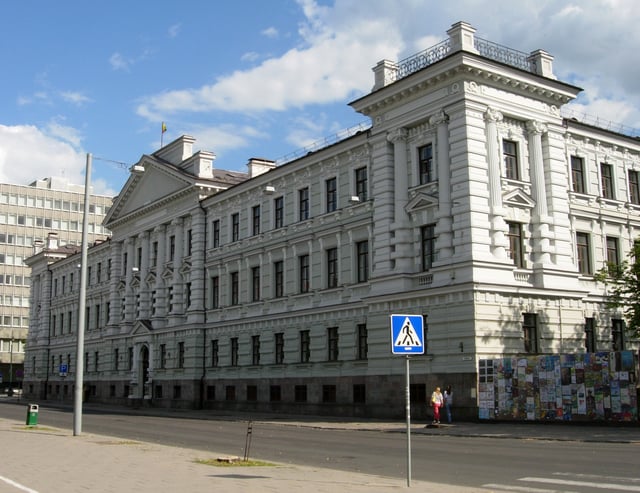
The former building of the KGB in Lithuania.
The republican affiliation offices almost completely duplicated the structural organization of the main KGB.
KGB of Belarusian SSR / KDB of Belarus (see State Security Committee of the Republic of Belarus)
KGB of Ukraine / KDB of Ukraine (see Committee for State Security (Ukraine))
KGB of Moldovan SSR / CSS of Moldova
KGB of Estonian SSR / RJK of Estonia
KGB of Latvian SSR / LPSR Valsts drošības komiteja (VDK)
KGB of Lithuanian SSR / VSK of Lithuania
KGB of Georgian SSR / KSU of Georgia
KGB of Armenian SSR
KGB of Azerbaijan SSR / DTK of Azerbaijan
KGB of Kazakh SSR
KGB of Kyrgyz SSR
KGB of Uzbek SSR
KGB of Turkmen SSR
KGB of Tajik SSR
KGB of Russia (created in 1991; see Federal Security Service)
Leadership
The Chairman of the KGB, First Deputy Chairmen (1–2), Deputy Chairmen (4–6). Its policy Collegium comprised a chairman, deputy chairmen, directorate chiefs, and republican KGB chairmen.
Directorates
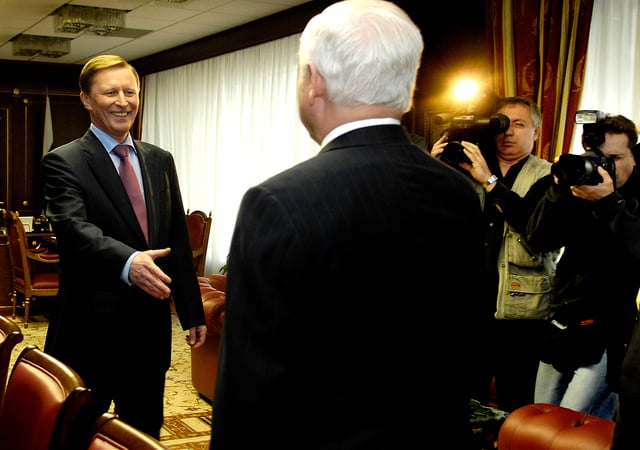
Former KGB officer Sergei Ivanov meets with former CIA director Robert Gates, April 2007
First Chief Directorate (Foreign Operations) – foreign espionage (now the Foreign Intelligence Service or SVR in Russian).
Second Chief Directorate – counter-intelligence, internal political control.
Third Chief Directorate (Armed Forces) – military counter-intelligence and armed forces political surveillance.
Fourth Directorate (Transportation security)
Fifth Chief Directorate – censorship and internal security against artistic, political, and religious dissension; renamed "Directorate Z", protecting the Constitutional order, in 1989.
Sixth Directorate (Economic Counter-intelligence, industrial security)
Seventh Directorate (Surveillance) – of Soviet nationals and foreigners.
Eighth Chief Directorate – monitored-managed national, foreign, and overseas communications, cryptologic equipment, and research and development.
Ninth Directorate (Guards and KGB Protection Service) – The 40,000-man uniformed bodyguard for the CPSU leaders and families, guarded critical government installations (nuclear weapons, etc.), operated the Moscow VIP subway, and secure Government–Party telephony. President Yeltsin transformed it to the Federal Protective Service (FPS).
Fifteenth Directorate (Security of Government Installations)
Sixteenth Directorate (SIGINT and communications interception) – operated the national and government telephone and telegraph systems.
Border Guards Directorate responsible for the USSR's border troops.
Operations and Technology Directorate – research laboratories for recording devices and Laboratory 12 for poisons and drugs.
Other units
KGB Personnel Department
Secretariat of the KGB
KGB Technical Support Staff
KGB Finance Department
KGB Archives
KGB Irregulars
Administration Department of the KGB, and
The CPSU Committee
KGB Spetsnaz (special operations) units such as:
- Alpha Group
- Vympel Group
- Zenith Group
Kremlin Guard Force for the Presidium, et al., then became the FSO
List of chairmen

Identity cards The Chairman of the KGB of the USSR Yuri Andropov.
| Chairman | Dates |
|---|---|
| Ivan Aleksandrovich Serov | 1954–1958 |
| Aleksandr Nikolayevich Shelepin | 1958–1961 |
| Pyotr Ivshutin | act. 1961 |
| Vladimir Yefimovich Semichastny | 1961–1967 |
| Yuri Vladimirovich Andropov | 1967–1982 (Jan.–May) |
| Vitali Vasilyevich Fedorchuk | 1982 (May–Dec.) |
| Viktor Mikhailovich Chebrikov | 1982–1988 |
| Vladimir Aleksandrovich Kryuchkov | 1988–1991 |
| Leonid Shebarshin | act 1991 |
| Vadim Viktorovich Bakatin | 1991 (Aug.–Nov.) |
Insignia
See also
Active measures
Central Department of Social Affairs
Chronology of Soviet secret police agencies
Dirección de Inteligencia
Eastern Bloc politics
Federal Agency of Government Communications and Information
Federal Protective Service
Federal Security Service (KGB successor in Russia)
Foreign Intelligence Service
Security Service of Ukraine
State Security Committee of the Republic of Belarus
History of Soviet espionage
Index of Soviet Union-related articles
ISI/FIA/IB
National Directorate of Security (KHAD successor in Afghanistan)
Ministry of Internal Affairs
Ministry of Public Security of Laos
Ministry of Public Security of Vietnam
Ministry of State Security
Mitrokhin Archive
Numbers station
RAW
State Security Department
SMERSH
Venona project
World Peace Council



